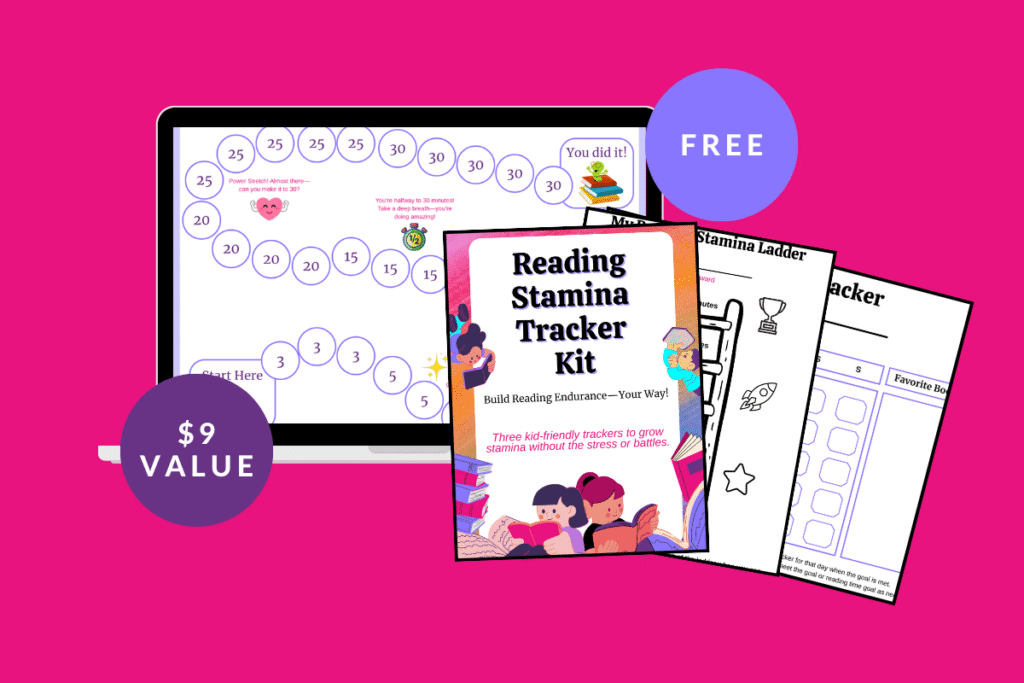When Your Child Refuses to Read Aloud
🎧 Prefer to listen or 📺 watch instead?
This post is also available as a podcast episode and YouTube video.
How to keep reading time from turning into a power struggle
You grab the book, slide it across the table, and ask, “Wanna read the first page together?”
Your kid barely looks up. Groans. Maybe scrunches their face or flat-out says “no.”
Sometimes it’s a quiet shrug. Other times it’s a full-on refusal. Either way, it’s frustrating. Especially when you know your kid can read, or when reading aloud used to be the one thing that didn’t cause a fight.
Suddenly, you’re left second-guessing everything:
Should I push a little? Back off completely? Are we losing ground?
This doesn’t mean you’ve messed anything up—and it doesn’t automatically mean your child is falling behind. But it does mean something’s getting in the way–and that’s worth paying attention to.
This post isn’t about powering through or convincing your child to cooperate. It’s about noticing what might be going on underneath the pushback—and making some tweaks that can help ease the tension and rebuild some trust around reading time.
Let’s look at what could be happening when your child resists reading aloud—and what to try instead.

Why Reading Aloud Can Feel Risky for Kids
Reading aloud seems simple. But for a lot of kids? It feels like a spotlight.
They don’t know which word is coming next. They’re trying to sound fluent, keep up the pace, and not mess up. And if they’ve ever been corrected mid-sentence, felt behind their classmates or siblings, or just had a rough reading moment that stuck with them. Their brain starts linking reading aloud with that uncomfortable feeling of being watched, or getting it “wrong.”
Even small stumbles can feel big when you’re the one in the hot seat.
Especially if your child is…
- A perfectionist who hates making mistakes
- Worried about being “behind”
- Struggling with reading confidence
- The type who holds onto things people say
- Or used to being praised mostly for “getting it right”
It’s not about attitude or effort—it’s about self-protection. Their brain is doing what it’s wired to do: trying to avoid the discomfort of embarrassment. So while we’re just thinking, “Let’s read together,” their brain is sounding the alarm: “Don’t mess up. Don’t get it wrong. Just don’t read.”

A Personal Story: When My Child Refused to Read Aloud
I saw this play out with Hunter (my youngest) in a big way.
Kindergarten started off rough. We didn’t know for sure that he had ADHD yet, and without the right support, every day felt like a struggle. He was constantly being corrected, his handwriting was barely legible, and no matter how hard he tried, and even though his teachers were doing their best, the message he was picking up was: You’re doing it wrong.
That kind of feedback, over and over? It takes a toll. It slowly chipped away at his confidence.
And here’s the thing—once that confidence starts to slip, it doesn’t just bounce back automatically.
Even after we got the right pieces in place—even after we could see how much progress he was making–he still didn’t want to read out loud. Not even at home with us.
And it wasn’t because we were correcting him—we just wanted to hear him. But by then, reading aloud already felt tied to the things that had gone wrong. He’d started telling himself, “I’m no good at this, I’m just not a reader.” And then he shut down.
So we had to shift gears. Not by pushing harder—but by helping him feel safe and successful again. Because pushing harder doesn’t build stamina, it builds avoidance.
Little by little, with a few specific tweaks (the same ones I’m about to share with you), the walls started to come down and the resistance eased up.
A few words here, a short sentence there. Eventually, a full page and most recently a full story.
So if reading aloud has become a sticking point in your house too, you’re not stuck, and this post will help you find your way through.
What to Do When Your Child Refuses to Read Aloud
Pushing your child to read aloud when they’re already anxious rarely builds confidence—it chips away at it. But that doesn’t mean you need to give up or avoid reading altogether.
Here are a few ways to support your child while slowly rebuilding their comfort level with reading aloud:
1. Make Reading Aloud Feel Less Intense for Anxious or Reluctant Readers

Reading aloud doesn’t have to mean powering through an entire book out loud. In fact, it shouldn’t—especially if your child is already resisting.
Try this instead:
- Letting them read signs, menus, instructions or captions—everyday stuff that makes reading feel natural
- Invite them to read one silly sentence or a favorite line they already know
- Encourage whisper reading, silly voices, or reading to a pet or a stuffed animal
- Allow them to return to a well-loved book they’ve basically memorized (comfort = confidence)
JD used to flip through his joke book just to find one to share with Grandpa—and every time he read one aloud, that was a win. The point isn’t what they’re reading—it’s how they feel while reading it.
You can also model reading aloud yourself while they’re doing something low-key like building with blocks, drawing, or playing with clay. No spotlight. No pressure. Just a story to enjoy in the background, ready for them to jump in if and when they want to.
Bonus tip: Try a setting shift! Flashlight reading under a blanket, snuggled-up on a different couch, or outside on a picnic blanket read outside on a blanket—all help reframe reading aloud as an adventure not an assignment.

The goal here? Show your child that reading aloud can feel light, safe, even fun.
2. Use “I Read / You Read” to Help Kids Ease Into Reading Aloud
This was one of the first strategies that worked with Hunter. We’d take turns—I’d read most of the sentence and he’d read the final word, then one line, one page, whatever he felt comfortable with.
Here’s the trick: let your child decide which parts they want to read. That little bit of choice gives them a sense of power and control—without overwhelming them.
Over time, they’ll often start doing more and more on their own—without you having to push for it.

Want a simple way to notice that progress? The Reading Stamina Tracker Kit is perfect for this. No stickers or point systems required—just a simple visual that helps your child see how far they’ve come.
3. Invite Them In, Don’t Put Them On the Spot
There’s a big difference between, “Okay, your turn to read,” and a soft invitation.
Try:
- “Want to read the silly voice part?”
- “Want to give this part a try?”
- “How about I start and you jump in when you’re ready?”
If they say no, that’s okay. You’re building a new pattern in their brain—one where reading isn’t something they’re expected to perform on command. You’re making it something they can step into when they feel ready.
4. Celebrate When Your Child Reads Aloud—Even in Small Ways
One of the fastest ways to rebuild reading confidence is by noticing when your child shows up to the story—not just when they read perfectly.
Look for moments to say:
- “Thanks for reading that part—I liked hearing it in your voice.”
- “You read even when you were nervous. That takes guts.”
- “That was tricky, but you kept going. That’s real progress.”
We’re not just praising fluency—we’re reinforcing that effort matters more than perfection. That’s what builds safety. That’s what builds trust.

What If Your Child Still Refuses to Read Aloud?
It’s okay. This is a long game—and sometimes kids need a complete reset before they’re willing to try again.
In the meantime, here’s where you can start:
✨ Take the Pressure Off—Read toThem
Read aloud to your child—even if they’re perfectly capable of reading on their own. This isn’t just about modeling fluency, it’s about connection. When you read to them, you’re taking the weight off their shoulders and giving them the space to just listen, imagine and reconnect with books in a way that feels easy.
And when anxiety’s been building, listening can be that bridge that gets them curious again.
💡 Need more ideas to gently build motivation and confidence?
You might find the Motivating Reluctant Readers Guide helpful—it’s full of practical, encouraging strategies that go beyond rewards and work with your child’s personality.
✨ Try Different Book Formats to Spark Read-Aloud Confidence
If reading aloud still feels like a no-go, try switching what your child is reading—not just how they’re reading it.
This isn’t about another fun voice or reading game. This is about changing the entire format.
Try:
- Audiobooks while playing with Legos or coloring
- Following along in a book while listening to the audio version
- Reading graphic novels, joke books, or picture books with minimal text
- Choosing interactive books like Don’t Push the Button! or Don’t Let the Pigeon Drive the Bus that invite playful engagement
This signals: reading doesn’t have to look a certain way to “count.”
Every story your child engages with—whether they hear it, see it, or read it in short bursts—helps build fluency, vocabulary, and confidence.
You’re helping them rebuild that belief:
- “I can do this.”
- “Books are for me.”
- “Reading doesn’t have to feel scary.”

Final Thoughts: Rebuilding Confidence in Reluctant Readers
Refusing to read aloud isn’t just about the words on the page—it’s often about what’s bubbling underneath: fear of messing up, feeling behind, or just plain burnout.
So if your child is pushing back, it’s not a sign to push harder. It’s a signal to pause and offer a gentler way in.
That might look like one shared sentence, one silly line read in a goofy voice, one moment where they feel safe instead of self-conscious. Because when the pressure lifts, kids have space to try again. And once they start to believe, “Hey…I can do this,”—that’s when things begin to click.
Want a Simple Way to Track Progress—Without the Pressure?
Try the Reading Stamina Tracker
This free visual tool gives your child a low-stress way to track how long they’re reading—solo or with you—points or pressure.

More Help for Making Read-Aloud Time Easier
Motivating Reluctant Readers Guide – A step-by-step guide to uncover why your child avoids reading and how to motivate them without bribes or constant reminders.
Create the Invitation to Read Mini Course – Learn how to make books so visible and inviting in your home that your child naturally wants to pick one up.
How to Set a Reading Goal That Actually Sticks – Gentle, realistic goal-setting ideas to help your child feel ownership and success without overwhelm.
How to Build Your Child’s Reading Stamina Without the Power Struggles – Strategies for stretching their reading time without nagging, tears, or eye-rolls.
Why Reading Aloud Still Matters Even After Your Child Learns to Read – The surprising benefits of continuing read-aloud time well beyond the early years.
FAQs: When Your Child Resists Reading Aloud
What if my child flat-out refuses to read aloud—should I make them try anyway?
Nope. Forcing it usually backfires. Instead, focus on helping reading feel safe again. Try shared reading, audiobooks, or reading to them while they build with Legos or draw. That gentle reset often leads to more willingness down the road.
Will they fall behind if they aren’t reading out loud regularly?
Reading aloud can support fluency—but it’s not the only way. Listening to stories, following along in books, and engaging with text in everyday life (signs, menus, captions) all build important reading muscles, too.
What’s a good first step if my child has reading anxiety?
Start small. One silly sentence. One joke from a favorite book. Or simply read with them (instead of asking them to read to you). That helps lower the pressure and rebuild trust.
Should I correct them when they make mistakes while reading aloud?
Not at first. Let confidence take root before you jump in with corrections. Once your child feels safer, you can gently model or revisit tricky parts without interrupting the flow.
Does it still count if they whisper-read, repeat something memorized, or follow along silently?
Yes, it absolutely counts. Whispering, echoing, or even repeating favorite lines can help kids feel more confident and stay connected to the story. When they follow along while you read—or listen to an audiobook—it helps them link what they hear with what they see on the page. These aren’t shortcuts; they’re helpful stepping stones that support growing readers in a way that feels safe and doable.



3 Comments